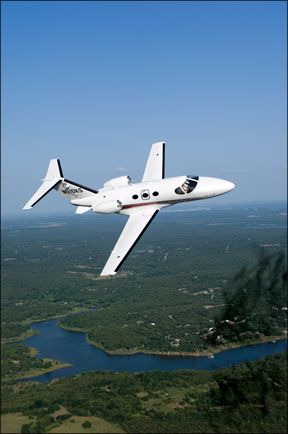Cessna calls its Citation Mustang an “entry level jet” rather than the now ubiquitous very light jet appellation. That might be because Cessna has no pretensions about who will buy Mustangs: mostly individual owners rather than the corporate and charter world.
No matter what you call the Model 510, its a sophisticated jet that, in our flight trial, handily beat book performance by a whopping 17 knots in cruise, has
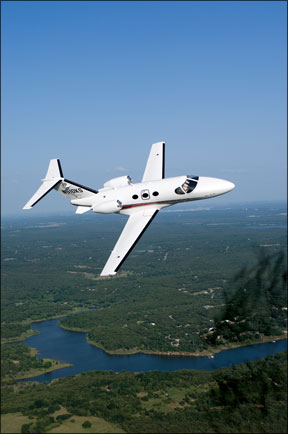
excellent fit and finish, a friendly aircraft/avionics/pilot interface and a cabin thats large enough to seat six adults comfortably.
Having built and flown its first jet in 1954 (the Air Force T-37 trainer), Cessna has been producing turbine airplanes for over half of its 80-year corporate history. The VLJ marketing frenzy was we’ll underway in 2002 when Cessna announced it would enter the fray and build the Mustang. While other manufacturers experienced certification delays, Cessna gave the appearance of a duck gliding across the pond toward September 2006 certification, achieving this milestone without appearing to break a sweat. Those who grasp the staggering costs and technical expertise required to certificate an airplane under the current FARs would understand the thrashing about that was going on subsurface as the duck sailed along serenely. But the final airplane gives little evidence of birthing pains.
The Basics
The Mustang is the smallest of the Citations, just 40 feet 7 inches long, with a wingspan of 43 feet 2 inches. Its powered by two Pratt & Whitney PW615F full FADEC turbofan engines delivering 1460 pounds of thrust each. TBO is 3500 hours. With the benefits of FADEC arresting start-up overtemps, we predict TBO will rise with service experience. The higher specific fuel consumption of a turbofan versus
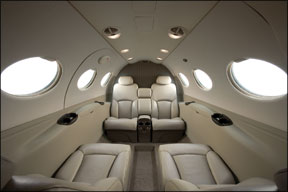
a piston engine means that a small jet faces the huge challenge of finding room to carry enough fuel to give it competitive range. we’ll step right into the major question for any of the VLJs: Can it carry fuel and people and get anywhere?
The Cessna 510 carries 2580 pounds of usable fuel in two wing tanks and has a maximum ramp weight of 8730 pounds. The airplane we flew had a basic empty weight of 5337 pounds, allowing for 813 pounds for people and baggage. That should translate into four people and light baggage. With full fuel, the Citation Mustang, in still air, has an NBAA IFR range of 1150 miles, which means an optimum climb to FL410, operation at max cruise power, an optimal descent and enough fuel to miss the approach, fly 100 miles to an alternate and hold. Make or break for light jets is whether ATC will allow them to climb efficiently to FL410, which is the only way theyll reach their range potential.
The Mustangs fuselage has a vaguely Citation look to it, but closer examination reveals that its distinctly its own design. The cabin windows are high on the curve and oriented horizontally, rather than vertically, giving passengers a wide field of view without having to contort themselves to peer outside. The fuselage is round on the top half, but flattens at the floor section to increase foot room. Inside the cabin, we found that the shape worked we’ll and was roomier than we expected in a jet of this size. Its the first of the VLJs in which we didnt feel crowded for head or leg room. The club seating will comfortably fit four adults and there’s a potty, with privacy curtains, opposite the door.
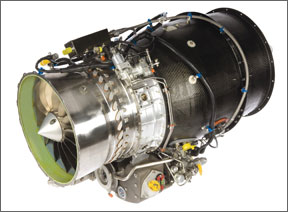
The Mustangs airframe is mostly aluminum, with composites used fairings. It has clearly been designed to be maintenance friendly and there’s no system in the airplane thats buried under another system or component. The fuselage sits on top of the wing, so there’s substantial faired-in space under the lower curve of the fuselage thats used to route various systems and plumbing, making access to them easy.
Other components have been designed with ease of replacement in mind. Both the wing deice boots and the heated glass windshields can be removed and replaced in less than four hours. Hydraulics power only the landing gear and the brakes. The reservoir sight gauges for these are in plain view on the aft bulkhead of the forward baggage compartment and no hydraulic lines pass through the pressure vessel. The wing is swept 11 degrees at the leading edge, almost not at all at the trailing edge. Aft lies a T-tail, as we’ll as rear fuselage strakes, which reduce the potential for a deep stall.
There’s no fuel in the fuselage, nor any fuel lines, a design we applaud. There are two baggage compartments outside of the pressure vessel, one in the nose and one aft. The aft compartment has a clever extension allowing skis or golf clubs to be carried. Our sample loading problems didnt expose any tendency to load out of the forward or aft CG limit.
The Mustang is certificated for flight into known icing and uses pneumatic boots, with VGs on the leading edges of the wing boots. We were told that they substantially increased the efficiency of the boots.
Bleed air is used for engine inlet anti-icing and DC power is used for the various zones to heat and defrost the windshields. There are no AC-powered systems in
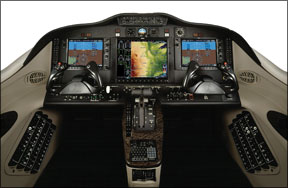
the airplane, thus no inverters, simplifying the electrical system, a standard 28-volt dual-bus system with a 300-amp starter generator on each engine. Should one fail, load shedding is automatic, requiring no action by the pilot. Should both fail, an independent standby battery will power essential electrical equipment for an hour.
Max pressurization differential is 8.6 PSI through an automated system that requires only setting the altitude of the destination airport before takeoff. Normal differential is 8.5 PSI and gives a cabin altitude of a little less than 8000 feet at the max operating altitude of FL410.
New Methods
We were especially interested in the fit and finish of the airplane because its being built at Cessnas Independence, Kansas, facility, where piston-engine airplanes are
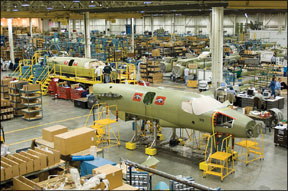
also constructed. The fit and finish of the airplane we flew as we’ll as the ones on the Independence assembly line seemed flawless. We were told that nearly 100 production personnel from Independence were relocated to Wichita for about a year to learn Citation production techniques. In addition, the production jigs and techniques for the Mustang were designed as the next step up from current Citation production. In turn, they are being used as the basis for the manufacturing process for the upcoming CitationJet IV.
In order to get a smooth, accurate exterior fuselage profile, the bonded aluminum fuselage skins are placed in the assembly jigs, then vacuum is applied and the skin is sucked out against the jig, precisely establishing the exterior diameter. The stringers and bulkheads are then installed from within, thus holding the exact external curves. Its backwards compared to what weve seen for decades, where the skins are stretched over the bulkheads and stringers, yielding a less true surface.
The Mustang is the first cabin-class airplane that weve experienced in which the travel of the pilots seat in the horizontal and vertical was adequate for virtually all pilots who might fly it. Three-point restraints are standard but would we prefer four-point restraints for the pilot seats and feel that they would be good candidates for shoulder harness airbags.
Entry to the front seats is easier than other business jets as the console between the seats doesnt extend so far aft as to require a gymnastic exercise to get past. Once in place, the controls fall easily to hand, with switches laid out sensibly. The panel is clean, dominated by the 10- and 15-inch displays that make up the
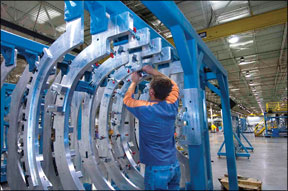
Mustangs version of the Garmin G1000 avionics suite. There are no overhead switches to poke holes in your cranium in the event of a sudden stop after running off the end of a runway. The yokes project from the panel, which is better than rising on columns from the floor, but they still block the view of some anti-ice switches. From a crashworthiness standpoint, we prefer side sticks over a yoke. Cessna said it is still eyeing that question, but elected to stick with yokes to address complexity in the control system.
Flight controls are actuated via pushrods and cables. All primary control surfaces have electrically actuated trim tabs; the elevator trim can also be adjusted manually. A yaw damper is installed and is required only for high-altitude flight. The yaw damper is an effective tool in the event of an engine failure; just apply the appropriate amount of rudder and turn on the damper, which then takes care of rudder application.
Flying It
The Mustangs checklist reflects a recognition that this airplane is targeted at the owner pilot rather than the professional pilot. Its short and to the point, with most tasks handled automatically. Starting an engine consists of pushing and releasing one button, watching N2 percent RPM and moving the power lever to idle when it hits 10 percent. The G1000 system comes alive and initializes in a short time, usually by the time it takes to plug in the amazingly slow V1, Vr and V2 speeds. At our weight, these were 85, 85 and 95 knots, respectively.
One of the advantages of FADEC is so much reduction of residual engine thrust that neither thrust reversers nor attenuators are needed for landing, saving substantial weight. But it also means that the airplane doesnt roll away from parking without pushing up the power a little. Steering is easy and precise with little tendency to overcontrol. Pre-takeoff chores are minimal and are probably doable on the roll by a competent single pilot.
Setting power for takeoff requires simply pushing the power levers forward to the takeoff position. The computers set thrust appropriately for temperature and altitude and the engines spool rapidly and generate a satisfactory shove back into the seat that you expect with jets. Whats unexpected is how quickly the airplane accelerates to Vr and is up and off the pavement. Ground roll was under 2000 feet.
Cessna was conservative in certificating the Mustang, choosing to go with FAR Part 23 commuter certification, which requires publishing a balanced field length for takeoff. At sea level on a standard day, at gross, the balanced field length is 3110 feet, which means that the airplane can accelerate to V1, lose an engine and either stop or go and clear a 35-foot obstacle in that distance. Given that almost no piston twins will accelerate to Vmc, tank an engine and come to a stop in that distance, we think that the Mustang will be safer to operate off short runways than the piston twins using them now.
Once aloft, the gear comes up at positive rate, with the flaps retracting at about 500 feet AGL and power reduced one click to let the FADEC set it for climb, where it remains, untouched, until leveling off. Control response is solid, but slightly heavy; it feels like a serious transport, not something to be tossed around. With no nose ahead for pitch reference, a pilot new to jets will find himself head down almost continuously during the climb as he works on speed control and adjusts to the steep deck angle generated by the initial climb rate of about 2500 FPM at 120 knots. Visibility is excellent. The windshield and side windows look slightly odd from the outside, but once inside, its apparent they were designed to maximize pilot visibility. The field of view is so sweeping that, looking outside and aft, the pilot can see about half of the left engine inlet and when maneuvering in the pattern, the windshield extends upward far enough that the runway doesnt disappear in a right turn from downwind to base or final.
Accelerating to a cruise climb of 160 knots reduces climb to below 2000 FPM. Nevertheless, even on a warm day of ISA +14 degrees in a cruise climb with two stops ordered by ATC, we reached FL310 in 17 minutes. The autopilot interface with the G1000 proved smooth and easy to program on the somewhat complex route we flew.
Level off at FL350 required simply pulling the power back one notch to the cruise detent, where the FADEC set max cruise while we waited for the airplane to stabilize to see if it would match published performance figures. At ISA plus 1 degree C, Cessna says the airplane cruises at 340 knots true. We observed 357 knots. Fuel flow was 330 PPH on the left engine and 320 on the right-about 97 GPH total.
While Cessna has a reputation for being conservative in publishing performance figures, we have never seen book cruise exceeded by 5 percent. Mmo is .63 Mach; we were cruising at .617 Mach. That also meant a healthy power reduction to avoid overspeed when we started down. If the autopilot is programmed for a descent rate and power is not reduced adequately, the autopilot will initiate a pull up to keep indicated airspeed below Mmo or, at lower altitude, the Vmo of 250 knots indicated. We looked at performance at FL240, obtaining 339 KTAS with a fuel burn of 440 and 430 PPH and at just over 10,000 feet after reducing power to stay below Vmo, fuel flows of 450 and 440 PPH generated 273 knots true. Steep turns were challenging not because of any handling quirks, but because of a lack of pitch reference and any aural cues to speed changes, thus an out-of-trim situation or inattention can lead to altitude excursions. This is a characteristic of jets and isn’t peculiar to the Mustang. It will require education for pilots experienced only in propeller aircraft.
Stalls were consistent with other jets; the aircraft is slowed to stall warning angle of attack, the power levers are pushed full forward to the takeoff detent and the pitch angle is maintained as the airplane rapidly powers out of the condition and is cleaned up. There’s no discernable pitch moment with power change or gear or flap configuration change.
Instrument approaches are easy in the Mustang and can be flown at almost any speed. The gear can be extended at any speed up to redline, but max retraction speed is 185 knots indicated. Approach flap maximum speed is 185 knots indicated and full flaps at 150 knots indicated, which, combined with speed brakes, is plenty fast for all conceivable operations. For landing, Vref speeds are lower than for many piston twins. For our mid-weight operations, we used 88 knots. The angle of attack system provides a small green doughnut on the ASI that shows 1.3 Vso adjusted for the weight of the airplane, allowing precise speed control. Combined with anti-skid and effective brakes, the Mustang will be at home on shorter runways than we would feel comfortable with a Baron or a 310.
Fine tuning power settings on the approach proved to be easy. Power is pulled to flight idle at about 50 feet AGL and the airplane lands like a lighter piston machine. Once the mains touch, the speed brakes are extended with the pilots right thumb on the center of the left power lever knob, the nose is lowered and braking commences. Even with floating due to carrying speed above Vref, we had no difficulty stopping in less than 3000 feet of runway.
Conclusion
Besides excellent performance, one thing that will sell this airplane is Cessnas reputation for service. Cessnas CESCOM program is an online computerized maintenance record service for Citations and Cessna will be offering flat dollar-per-hour programs allowing owners to predict the cost for engine operation, parts replacement and inspections. We were told that a program to manage the various databases for systems and components (notably avionics) in the airplane is being set up. The Mustang will be incorporated into Cessnas worldwide service network.
Given all the false starts and setbacks in the VLJ market, the Mustang is a standout. Cessna delivered what it said it would, when it said it would. At $2.6 million, the Mustang is pricier than the Eclipse by about $1 million. But the airplane significantly exceeds published cruise performance claims and has enough useful load and range to be practical for the type of operator we imagine will buy it. For a person making a decision to buy an entry-level or VLJ or whatever its called, Cessna will have a player in the Mustang, despite the higher price. We think theyve created a thoroughbred.
Rick Durden is an
Aviation Consumer contributing editor.
